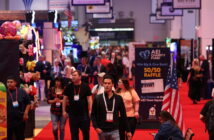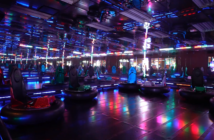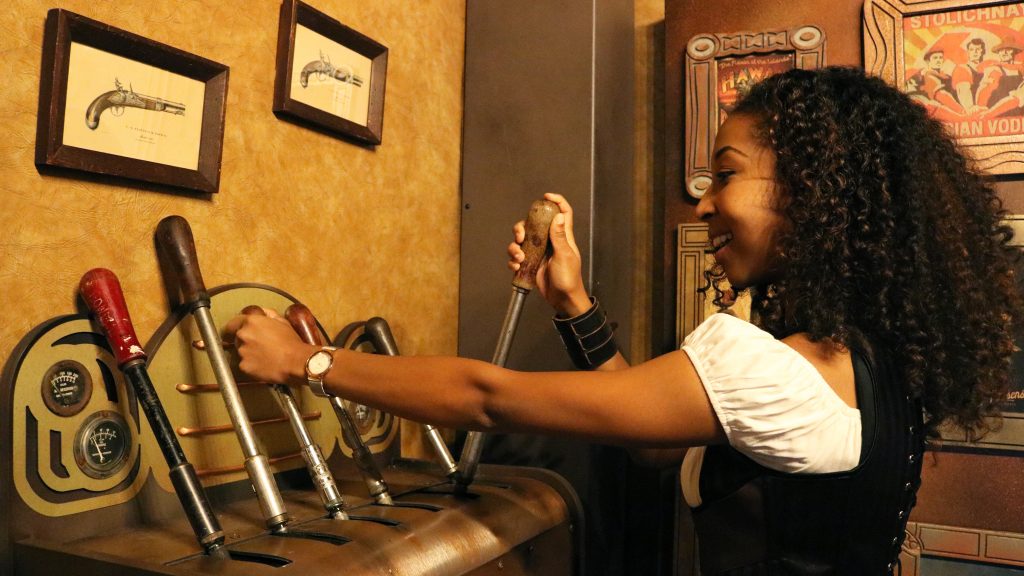 Escape Rooms Grow in Popularity
Escape Rooms Grow in Popularity
FECs’ Latest Trend in Out-of-Home Attractions Offers
New Form of Fun With Easy-to-Play, Hard-to-Win Puzzles
by Casey Minter
The clock winds down to its final moments as you frantically piece together the last clues and escape a horror-filled room. A light bulb flashes in your mind and you rush over to your team with the final clue. Together, you and your friends escape the CDC containment area (or the locked-down Louvre, the zombie-filled shack or the bank vault). With escape rooms, the attraction that’s been spreading like a wild fire throughout the country, creativity and cleverness reign supreme, both in the guests battling against the clock and in the location owner creating the experience.
The escape room concept seemingly originated in Japan circa 2007, inspired by point-and-click adventure video games. However, it wasn’t until 2012 that the U.S. saw its first rooms open, and now (according to the unofficial, but extensive, EscapeRoomDirectory.com) there are over 3,007 businesses operating 7,271 rooms globally. A scroll through the online directory will give you a good perspective on the breadth of themes and details of these locations, with rooms in 1,362 cities and 103 countries.
These numbers continue to grow as the concept takes hold of a wide array of demographics. Whether it’s a birthday party for a 60-year old woman and her friends or a group of youthful middle schoolers getting dropped off by their parents, the stats show that the experience is universally fun.
However, for the business looking to add this experience-driven attraction, the wide field of providers, franchises, DIY kits and other services offering escape rooms may seem daunting. Focusing on a few common ways operators are opening escape rooms offers a better chance to understand how the attraction may work for you, whether you decide to work with a franchised product like Creative Works’ Infinite Escapes, a different provider or decide to build out the attraction yourself.
The Basics…And the Challenges
Most escape rooms charge players $25 to $30 for an hour-long session, with some locations offering 30-minute sessions in smaller rooms. For owners, the chief operating costs are payroll and rent. The cost of building the room itself is variable depending on how elaborate or spartan the room and challenge is meant to be. Some puzzles require only a creative challenge, pen, paper and some props; others encompass multiple rooms, intricate locks and lasers, even virtual/augmented reality.
Despite continued growth across many markets, industry members like Eric Lloyd, co-founder of I.Q. Escape, a group dedicated to making high-end, in-depth escape rooms, are quick to highlight some of the difficulties involved with what may seem like a simple operation. According to Lloyd and others, encouraging repeat play, finding good real estate and maintaining the quality of your room are all conundrums as difficult to overcome as the quandaries your customers end up butting heads against.
“Don’t make the mistake of assuming that it’s easy to open one. The answer is, ‘Yes, you could open an escape room right now pretty much anywhere and you’ll make good sales,’” he said. “But it won’t last. A six- to eight-month investment prior to getting ready to open the game is what we advise. You need time to integrate the technology that will produce longevity and repeat play. A lot of people right now are simply seeing the good money and diving in without proper preparation.”
I.Q. Escape’s goal is not simply to introduce their customers to a good time, but to truly make them feel like they are in a dire situation in a dangerous and exciting place. Lloyd and his company want to make the player feel as if they’re in an action movie. Whether they do that by working with a French observatory to replicate the look of the stars in a Parisian alley or by emulating a CDC quarantine area so closely that even a CDC employee was fooled (true story!), the group is dedicated to authenticity.
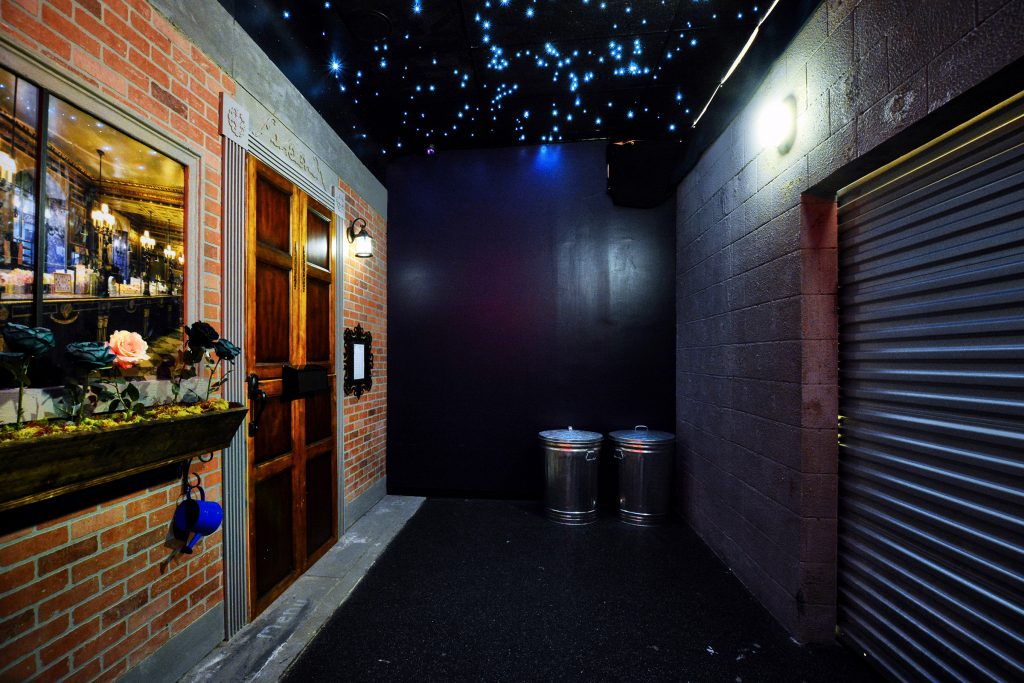
I.Q. Escape is so dedicated to details that they contacted a French observatory to perfectly emulate what the stars would look like in this Parisian alley.
Another key difference of I.Q. Escape: The final objective of their rooms is rarely as simple as finding a key to unlock a door. Whether the guest is dodging lasers to avoid setting off an alarm or frantically attempting to create an antidote for a worldwide virus, technology is integrated throughout. The company is also doubling the average escape room size to 1,000 square feet in order to incorporate the technology that makes realistic and challenging puzzles, and Lloyd believes a high initial investment will make them stand out.
“We have an aggressive growth strategy, mainly because we see so much room for expansion,” said Lloyd.
On to FECs
I.Q. Escape’s high-end, Pittsburgh-based model works well for their locations, but for existing FECs looking into adding escape rooms, Creative Works believes it has the solution. Essentially, if you have a space (250 square feet or more), Creative Works will come in and transform it with paint, props, puzzles and playful theming. The company also offers assistance in training and staffing the room.
“Basically, when we go in, it’s a blank room,” said Creative Works’ Chief Marketing Officer Danny Gruening. “When we’re done, it’s a fully functioning attraction.”
The company debuted its Infinite Escapes concept at IAAPA in 2016, hoping to better serve a market in between franchised, single-node attractions and DIY setups.
“We started our development process for Infinite Escapes in 2016, and after looking at the existing options, two ends of spectrum seemed covered: single-node locations and DIY setups. The FEC market is missed by current offerings. Many don’t want franchises, but don’t want to have to put in the work to do it themselves either. We wanted to find that middle ground for FECs, not a standalone setup but part of a whole offering.”
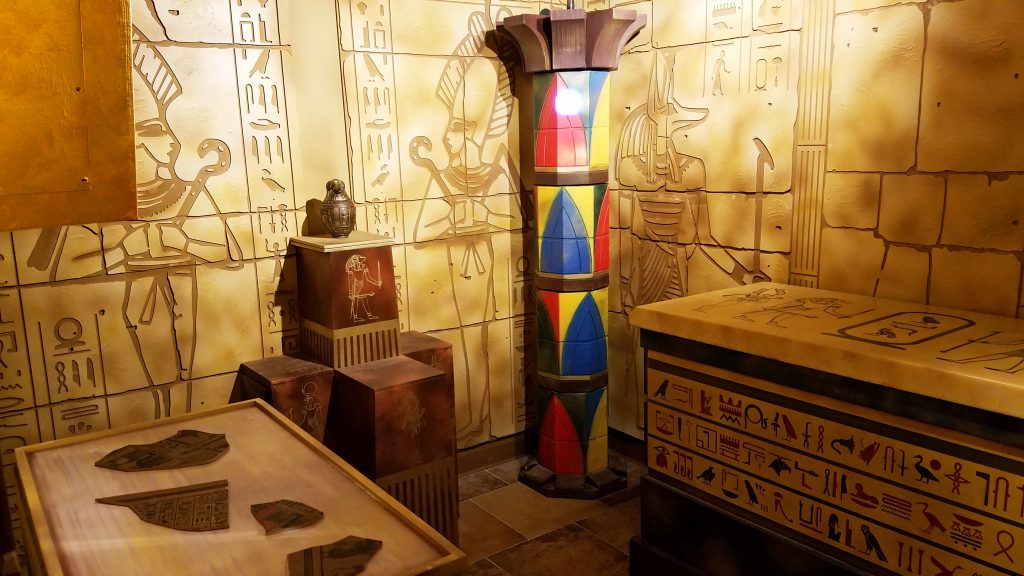
The Creative Works Pharaoh’s Revenge escape rooms in Eastern Shore Lanes in South Alabama.
When Gruening and his team were developing Infinite Escapes, they played dozens of rooms across the nation to test what was and wasn’t working. They realized that tactile, unique puzzles were the most appealing and memorable, causing the most joy or frustration when the team figured it out…or not.
Additionally, the company tapped into its extensive history in theming, believing that the more immersed players can be in the story created by the escape room, the more fun they had.
“Theming is what we do best,” Gruening said. “It’s the DNA of our company, and it shows in our first escape concept, Inventor’s Workshop. When you walk in and the door closes behind your team, you now longer feel like you’re in an FEC. You’re definitely a part of this story.”
No matter how intricate the theming, though, any puzzle or riddle won’t be as exciting the second time around. How can an FEC encourage vital repeat play? Gruening points to Infinite Escapes’ modular puzzles. Each room has a certain number of differing puzzles installed within it, so the location owner has access to a variety of ways to set up the room.
“They can change it depending on how much traffic they have,” Gruening said. “Some actually market it to their customers, saying every six months it will change, with ‘X’ many puzzles replaced. The storyline and theming remains the same, at least, so it makes logical sense, but the manner in which the room is completed will be different.”
With this in mind, Gruening still recommends those considering a new escape room attraction to open two separate rooms or more.
“What happens at an FEC is when someone plays one room and has a great time, they want to do it all over again, right then or next week,” he explained. “So if a center has a second room, they can get that immediate gratification. From a revenue and throughput perspective, that makes more sense.”
Creative Works has two themed storylines that are completed and ready for installation – Inventors Workshop and Pharaohs’ Revenge – and is working on a third, space-themed title now.
“The future is continually adding more and more of these themes so over time we have a greater collection for our customers,” Gruening concluded.
Do It Yourself
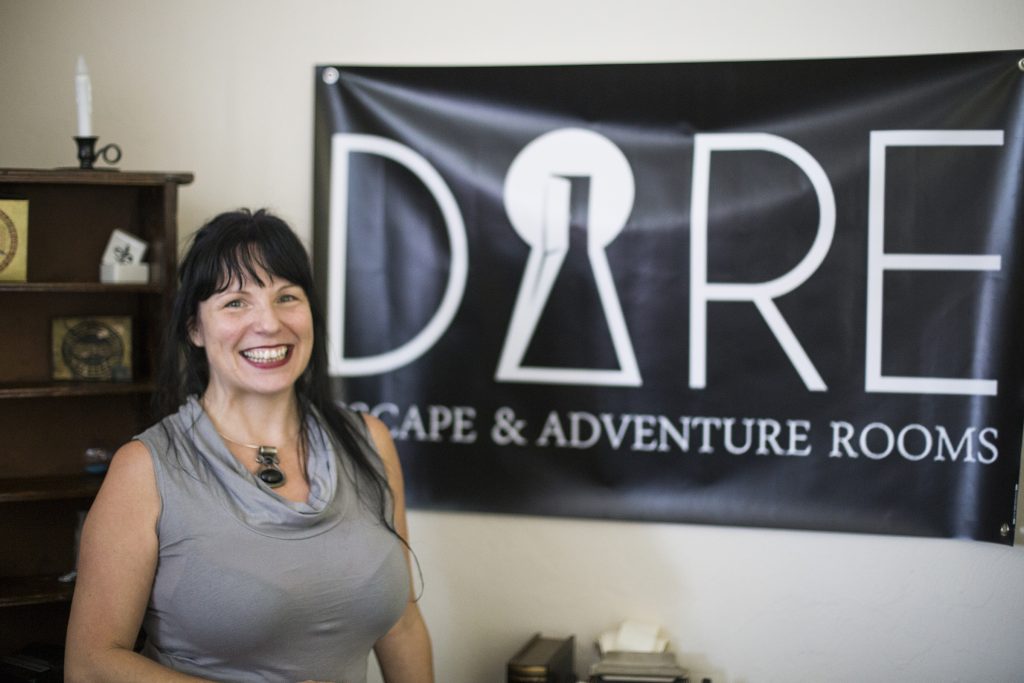
Michelle Dee, owner of Dare Escape Room in Eugene, Ore., opened her unique escape room and is already looking to open another.
You’ll find DARE Escape Rooms tucked away in the corner of a shopping center in Eugene, Ore. The businesses that used to occupy this hole in the wall could have been anything from auto insurance to retail. But now, the once-bland walls have been transformed to fit the theme of Michelle Dee’s terror-filled escape room. A variety of props and decorations, all scrounged from Dee’s innumerable trips to local thrift shops, cause intrigue before you even start the puzzle.
Dee opened up shop nearly two years ago and caters to the large college crowd in Eugene. Up to six players can go through her location, encouraging small teams or groups of friends to take up the challenge.
Dee took up a challenge herself opening DARE nearly a year ago as the first escape room concept in her city, jumping into a new market with little experience operating a room, but plenty of passion to make it great. Her location is an amalgamation of interesting knick-knacks; typewriters line one wall while the puzzles in her room are built into complex mechanical calculators and other items that are decades old. The repurposed detritus gives her room an incredibly unique look, and Dee says as long as she stays creative, she’s constantly finding new, fun additions.
Tackling a new business completely on your own like Dee did is a challenge many aren’t willing to undertake, but there are other ways to DIY with a little help in your back pocket. A company named Escape Realm offers another solution: modular puzzles that come outfitted with all the necessities but little setup support.
“Our games are packaged together in a pureed way,” said Cody Borst, lead developer at Escape Realm. “You get a box with all the hardware, puzzle info and everything you need to get started yourself. It’s not as turnkey as some installations. You have to do the buildout.”
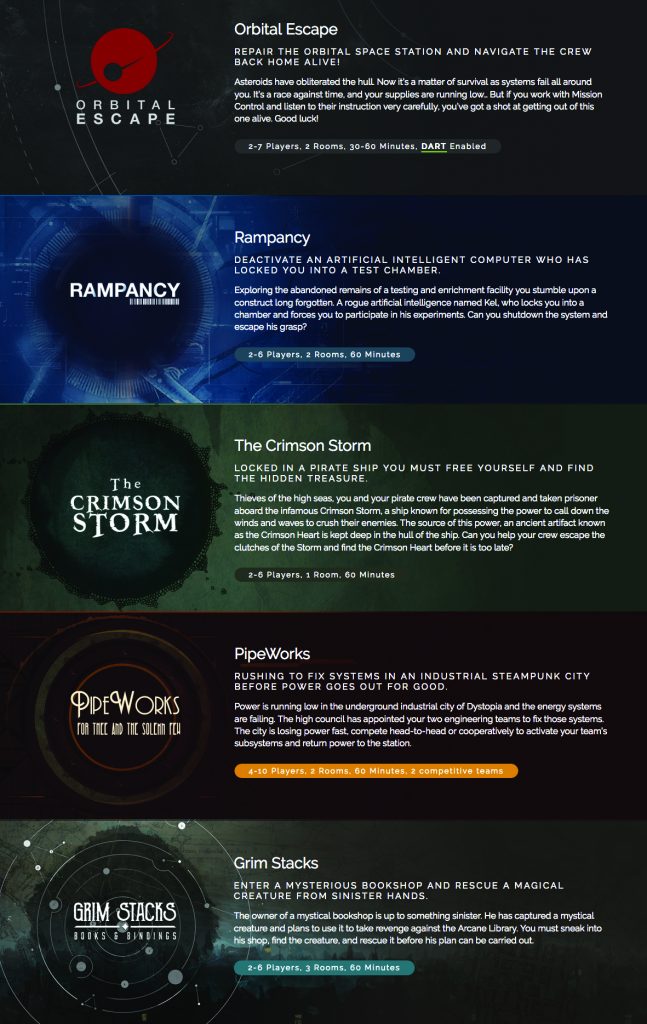
Games available from Escape Realm.
The exciting thing about Escape Realm’s concept is its ability to change on the fly. Borst says this gives their puzzles nearly infinite replayability and makes them more difficult than competitors’ games. Borst developed his own software system to control the many aspects of each game, giving the operator constantly updated info on a player’s progress and allowing them to adjust the time allotment and difficulty of each puzzle on the fly.
“After the boring things like signing liability waivers and entering account info, the player gets to create a profile that can be accessed online and is updated every time they play,” Borst said. “This adds some competition, and gets players coming back to improve or to beat their buddy’s time.”
The system also resets for another game quickly, making for short down times and high throughput, Borst said. Each Escape Realm puzzle is built with two elements: a physical, tactile challenge augmented by some type of digital interface. This allows each puzzle to keep players engaged physically while also giving operators the chance to constantly change the puzzles easily, through the digital aspect.
“Imagine you get info from a monitor or touchscreen. You have several pieces of acrylic hexagons in the room, you have to arrange those in a specific way to get the next information, which will take you to a touchscreen to solve another puzzle,” Borst said. “The next game you play, if you have the same puzzle, it will give you a different piece of info on the monitor and you arrange the props differently, then use the info you get from that differently.”
The concept was inspired by procedurally generated video games that proport to offer infinite replay value because the puzzles are constantly changing. Borst says, compared to Creative Works modular puzzle offerings, his system doesn’t require you to “gut and replace” each room, but is completely controlled through the software.
“If they don’t want to design the game from scratch, this is a great supplemental piece to the puzzle of opening up an escape room,” Borst said. “Those who want to get hands on can add their own puzzles, add their own whole game on top of it. And those who want can just make it work right out of the box.”
Escape Realm plans on offering consistent updates for its products, which began selling in April this year. The updates could add new game types, themes and more through simple, downloadable files. The fresh face this gives an escape room may prove vital; as the industry continues to grow, many warn of a saturation point that may have already been reached.
“We’re getting to the point now that it will involve a lot more to succeed with escape rooms,” Borst said. “Early adopters were able to bootstrap everything; we made it work with what resources we had. It was incredibly fun to start an industry out of nothing. Now, we’re getting to the point where you’ll see more high-production studios making escape rooms, establishing recognizable brands and games. Now, it’s almost like there are 2,000 independent theaters showing different movies across the U.S. I think in the coming years, we’ll see a lot of those close down and we’ll see more recognizable brands take their place.”
In order to stay relevant, Borst believes investment is key. The payoff for adding escape rooms is potentially huge, especially when one takes the initiative to install and conceptualize a lot of it themselves. But, as with any investment, there’s always the risk of losing. The concept is still in its novelty stages, basking in the glow of a good idea gone global. But, to keep the players coming in, innovation and persistence will be a necessity.
“Escape games have a very huge, quantifiable ROI compared to how little investment they require,” Borst concluded. “But the less money you put in, the less money you’ll make on it. The more we invest, the more we put our hearts and souls into design, the more money you can make and the more fun your customers can have.”
For more information on I.Q. Escape, visit pittsburgh.iqescape.com. For more on Dare Escape Room visit www.dareescaperooms.com. To learn more about Creative Works Infinite Escapes, visit www.thewoweffect.com. And to see what Escape Realm is about, go to www.escaperealm.com.


